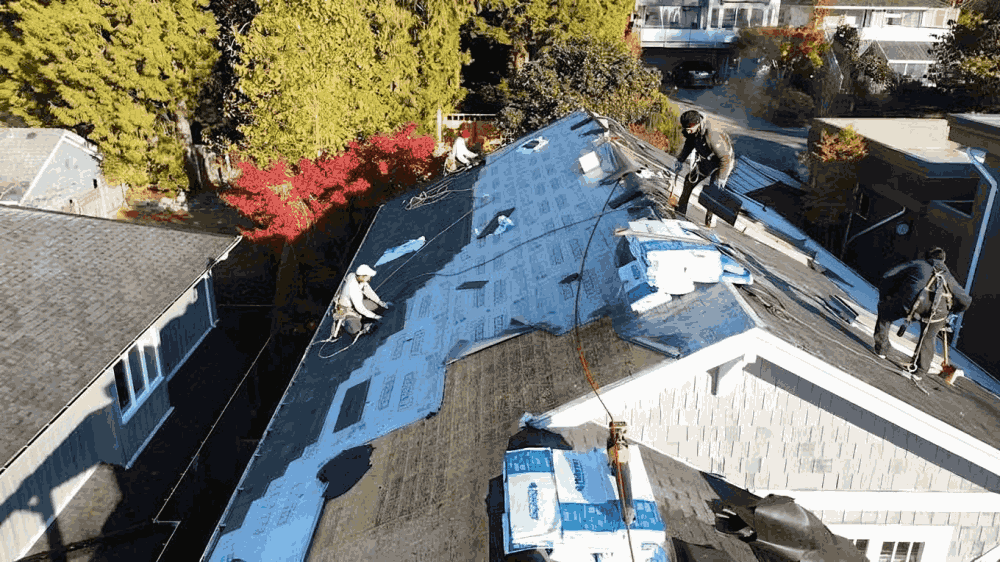When planning a new asphalt shingle roof, understanding the roof pitch—the angle or slope of your roof—is crucial. The roof pitch affects water drainage, impacts the roof’s durability, and determines the suitability of asphalt shingles for your home.
In Vancouver’s rainy climate, selecting the appropriate roof slope is vital to prevent water accumulation and potential damage. According to the British Columbia Building Code, asphalt shingles are suitable for roofs with a minimum slope of 1:3 (4:12). This means the roof rises 4 inches for every 12 inches of horizontal distance, ensuring effective water runoff.
Choosing the correct slope of roof not only extends the lifespan of your shingle roofing but also enhances your home’s structural integrity. In this blog, we’ll explore the key factors to consider when determining the minimum roof pitch for asphalt shingles, helping you make informed decisions for your roofing project.
What is Roof Pitch and Why Does It Matter?
The roof pitch is the angle or steepness of a roof. It’s usually expressed as a ratio of how much the roof rises vertically compared to its horizontal span. For example, a 4:12 pitch means the roof rises 4 inches for every 12 inches of horizontal run. This measurement isn’t just a technical detail—it plays a big role in how well your roof performs.
In areas like Vancouver, where rain is frequent, the roof slope matters more than you might think. A properly sloped roof ensures water drains efficiently, preventing it from pooling and causing leaks. The right slope of roof also helps distribute weight from snow during winter months, reducing the risk of structural damage.
Moreover, the roof pitch determines whether certain materials, like asphalt shingles, are suitable for your home. Shingles are designed to work best on sloped roofs because the incline helps them shed water and last longer. A roof that’s too flat can cause water to seep under the shingles, leading to costly repairs.
Understanding your roof’s pitch is essential for choosing the right materials and ensuring long-term durability. It’s not just about aesthetics—it’s about creating a roof that can stand up to the elements and protect your home effectively.
Minimum Roof Pitch for Asphalt Shingles
The minimum roof pitch for asphalt shingles is typically 2:12, which means the roof rises 2 inches for every 12 inches of horizontal distance. This is the lowest slope where shingles can effectively shed water. However, many roofing professionals recommend a pitch of at least 4:12 for better performance, especially in regions with heavy rain or snow, like Vancouver.
Why does this matter? A roof pitch below 2:12 isn’t steep enough for shingles to properly direct water off the roof. Water tends to linger, increasing the risk of leaks and damage over time. On the other hand, a steeper roof slope allows for faster drainage, which helps prolong the life of your shingles and reduces maintenance costs.
Asphalt shingles are versatile and affordable, but their performance depends on having the correct slope of roof. For flatter roofs, other materials like rubber or metal roofing may be more suitable. Ensuring your roof meets the minimum pitch requirements is key to preventing problems down the road. Always consult with a professional roofer to confirm that your roof’s slope matches the recommended guidelines for shingle roofing.
Factors That Influence Roof Slope Requirements
Several factors determine the ideal roof slope for your home. Understanding these helps ensure your roof performs well, especially in a climate like Vancouver’s. Here are the main considerations:
1. Climate Conditions
In areas with heavy rainfall or snow, like Vancouver, a steeper roof pitch is essential for effective water drainage and snow shedding. A low slope of roof in these regions can lead to water pooling, leaks, and structural issues. Conversely, in drier areas, flatter roofs may work just fine.
2. Roofing Materials
The type of material you choose also impacts the required roof slope. Asphalt shingles, for instance, need a minimum pitch of 2:12, but they perform better with a steeper angle. Other materials like metal or membrane roofing can handle flatter sloped roofs, making them ideal for certain designs.
3. Architectural Style
Your home’s design plays a role in determining the roof slope. Traditional homes often feature steeper sloped roofs for a classic look, while modern designs may use flatter roofs to achieve a sleek, minimalist aesthetic.
4. Local Building Codes
Building codes, such as those in British Columbia, often specify minimum roof pitch requirements based on safety and performance. These regulations ensure that your roof meets standards for durability and weather resistance.
5. Structural Support
The steeper the roof slope, the more support it requires. A roof’s angle affects its weight distribution, which is critical during heavy snowfalls or strong winds. Your roof structure must be built to handle these stresses.
Considering these factors can help you make informed decisions about your roof’s design and materials. Consulting a professional ensures your roof’s slope meets both aesthetic and functional needs, providing lasting protection for your home.
Why a Low Roof Pitch Can Be Problematic
A low roof pitch may seem like a sleek and modern choice, but it comes with significant challenges, especially in areas like Vancouver with frequent rain and snowfall. Here’s why a roof with a shallow slope can cause issues:
1. Poor Water Drainage
The main problem with a low roof slope is that water doesn’t drain efficiently. Instead of flowing off the roof, water can pool, increasing the risk of leaks and water damage. Over time, this can weaken the roof’s structure and lead to costly repairs.
2. Higher Risk of Shingle Damage
Asphalt shingles are designed to work best on sloped roofs where gravity helps them shed water. On a low-pitch roof, water can seep under the shingles, causing them to loosen or deteriorate faster. This reduces the lifespan of your shingle roofing and increases maintenance costs.
3. Snow Build-Up
In winter, snow can accumulate more easily on a low-pitch roof. This added weight puts pressure on the roof’s structure, which can lead to sagging or even collapse if the snow isn’t removed promptly.
4. Ventilation Challenges
A low slope of roof can make it harder to ensure proper ventilation. Poor ventilation traps moisture inside the attic, which can lead to mold, mildew, and higher energy bills as your heating and cooling systems work harder.
5. Limited Material Options
Not all roofing materials are suitable for low-pitch roofs. While options like metal or membrane roofing work well, asphalt shingles require a steeper roof pitch to perform effectively. This limitation might affect your design and material choices.
While low-pitch roofs may fit certain architectural styles, the risks often outweigh the benefits, particularly in climates like Vancouver’s. To avoid these issues, consult a roofing professional to ensure your roof slope is ideal for your home’s needs and local weather conditions.
Choosing the Right Pitch for Your Asphalt Shingle Roof
Selecting the correct roof pitch for your asphalt shingle roof is essential to ensure durability, water drainage, and overall performance. Here are some key tips to guide your decision:
1. Consider Your Climate
In rainy cities like Vancouver, a steeper roof slope is recommended. A pitch of at least 4:12 helps water drain quickly, reducing the chances of leaks and damage. Steeper sloped roofs are also better at handling snow, which can otherwise build up and strain your roof.
2. Match Your Home’s Design
Your home’s architectural style plays a role in deciding the roof pitch. Traditional homes often have higher-pitched roofs, while modern designs may feature a more minimal slope of roof. Balance aesthetics with functionality to ensure your roof complements your home while staying effective.
3. Follow Building Codes
Building codes in British Columbia provide guidelines for minimum roof pitch requirements. For asphalt shingles, a minimum pitch of 2:12 is usually acceptable, but higher pitches often perform better. Always check local regulations or consult a professional roofer to stay compliant.
4. Choose Durable Materials
While asphalt shingles are ideal for sloped roofs, they may not be suitable for flatter pitches. If your roof pitch is below 4:12, consider other materials like metal or membrane roofing, which work better on low slopes.
5. Consult a Professional
Every home is unique, and the right roof pitch depends on multiple factors like your home’s structure, local weather, and personal preferences. A roofing expert can evaluate your needs and recommend the best pitch for your shingle roofing.
Choosing the right pitch ensures your roof not only looks great but also provides long-lasting protection. By considering your local climate, design preferences, and professional advice, you’ll have a roof that stands the test of time.
Common Misconceptions About Roof Pitch
When it comes to roof pitch, several myths can lead to costly mistakes. Let’s clear up some common misconceptions:
1. Any Roof Pitch Works for Asphalt Shingles
Some believe asphalt shingles can be used on any roof slope, but that’s not true. Shingles require a minimum pitch of 2:12 to drain water effectively. Using them on a flatter slope of roof increases the risk of leaks.
2. A Steeper Roof Pitch is Always Better
While a steep roof pitch is great for water drainage, it’s not always necessary for all climates or materials. The ideal pitch depends on local weather, design, and the type of roofing you choose.
3. Flat Roofs are Cheaper to Build
Flat or low-pitch roofs may seem less expensive initially, but they often require specialized materials and maintenance. For example, sloped roofs with asphalt shingles are cost-effective and require less upkeep in the long run.
Understanding these myths helps you make better decisions for your roof, ensuring it lasts and performs well under all conditions.

Key Takeaways for Asphalt Shingle Roof Pitch
The roof pitch is a crucial factor in ensuring your asphalt shingle roof performs well and lasts long. Here are the key points to remember:
- Minimum Pitch Matters: Asphalt shingles need a minimum roof slope of 2:12, but a steeper pitch, like 4:12, provides better drainage and durability.
- Climate is Key: In rainy areas like Vancouver, a proper slope of roof helps prevent water pooling and leaks.
- Match Materials to Pitch: Asphalt shingles work best on sloped roofs, while flatter roofs may require other materials like metal or membranes.
- Consult the Experts: A professional roofer can recommend the right roof pitch based on your home’s needs, climate, and local building codes.
To learn more about maintaining and extending the life of your asphalt shingle roof, check out these 7 proven tips. Choosing the correct pitch and following these best practices ensures your shingle roofing provides reliable protection and enhances your home’s value.
CONCLUSION:
Getting the right roof pitch for your asphalt shingle roof is essential for both performance and durability. A proper roof slope ensures efficient water drainage, protects against leaks, and helps your shingles last longer—especially in rainy climates like Vancouver.
Whether you’re designing a new roof or upgrading an existing one, understanding the slope of roof requirements and consulting a professional can save you time and money. Remember, asphalt shingles work best on sloped roofs, so making the right choice is key to keeping your home safe and your roof in great condition.
If you’re unsure about your roof’s pitch or need expert advice, don’t hesitate to reach out to a trusted roofing professional. A well-pitched roof isn’t just a feature—it’s an investment in the long-term protection of your home.

